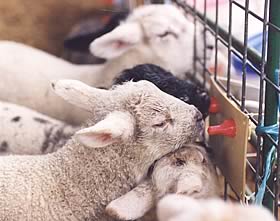 |
|||||||||
|
|||||||||||||||||||
|
|
Rearing
Surplus Lambs to Improve Flock Margins 27/03/08 Tighter lamb supplies are set to impact on the coming season’s marketplace and strengthen prices for earlier lambs, says Volac International’s Maggie Gould.
“Add to that figure a suggested reduction in mutton and sheepmeat production is set to fall by almost 2.5% on 2007,” she says. “Furthermore, while exports are likely to be up on the year and imports remain identical, the Commission forecasts that the total supplies of sheep meat to the domestic market to fall by 3.4%. “While all farmers will welcome the forecast trends, returns will continue to remain very slim. With the increasing likelihood of strong early season lamb prices, rearing surplus lambs is one obvious way of helping to improve overall margins for early lambing flocks. Lambs must be introduced to an efficient and cost effective system,” Maggie said. “Good husbandry is key, along with a system which offers high quality milk replacer, such as Volac Lamlac, on a little and often basis in order to reduce the risk of digestive upsets, encourage faster growth rates and save time at one of the most hectic periods.”
Rearing surplus lambs Surplus lambs should have the very best start in life if they’re to be reared successfully, says ADAS’s sheep consultant, Kate Phillips. Adopting the following ten point surplus lamb plan will ensure a well scheduled routine that will pay dividends in saving labour and lives.
|
||||||||||||||||||

|
|
||||||||||||||||||
| home | agri-services | pedigree
pen | news | dairy | beef | machinery property | organisations | site map |
|||||||||||||||||||

